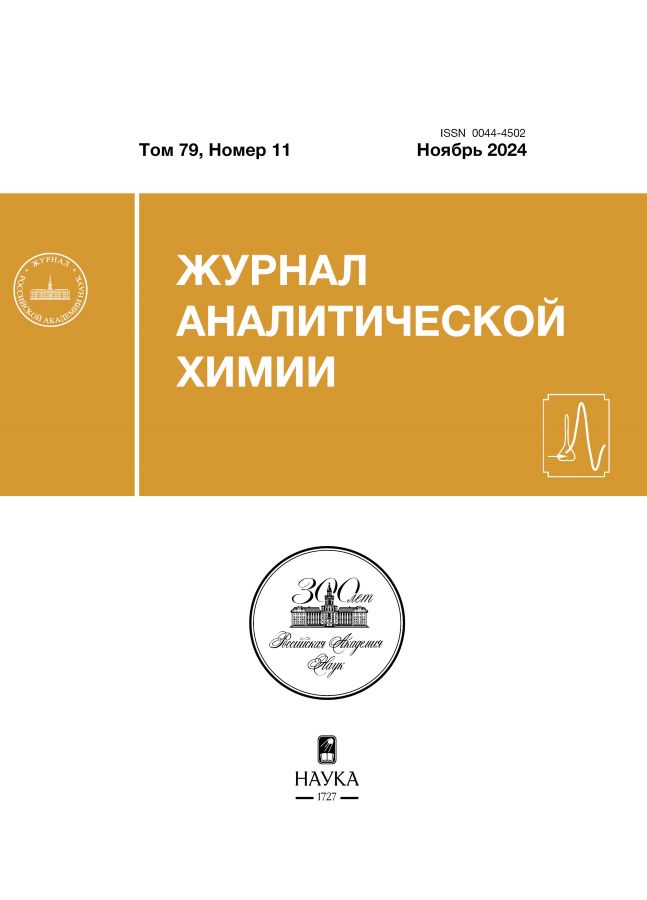Obtaining and optimizing the mass spectrometric determination of glutathione persulfide
- 作者: Ishkaeva R.A.1, Lopukhov L.V.1, Nizamov I.S.1, Abdullin Т.I.1
-
隶属关系:
- Kazan Federal University
- 期: 卷 79, 编号 11 (2024)
- 页面: 1237-1245
- 栏目: ORIGINAL ARTICLES
- ##submission.dateSubmitted##: 01.04.2025
- ##submission.dateAccepted##: 01.04.2025
- URL: https://bakhtiniada.ru/0044-4502/article/view/285975
- DOI: https://doi.org/10.31857/S0044450224110101
- EDN: https://elibrary.ru/swobts
- ID: 285975
如何引用文章
详细
Glutathione persulfide (GSSH) is an important cell metabolite involved in redox regulation and a potential therapeutic agent. Due to the instability and lack of commercial GSSH standards, an urgent task is to develop methods for its in situ generation and quantification in various test systems. The paper optimizes the conditions for obtaining GSSH in the reaction of oxidized glutathione with sodium sulfide with the aid of fluorescent monitoring of released hydrogen sulfide. The reaction was performed in the presence of an excess of N-ethylmaleimide to derivatize the generated GSSH and reduced glutathione (GSH) in similar amounts of both derivatives. A technique for determining GSSH by the level of GSH in a model reaction by HPLC-mass spectrometry in the multiple reactions monitoring mode is described. The contribution of the GSH impurity in the oxidized glutathione solution to the determined amount of GSSH as well as the detection limit of GSSH in the reaction mixture have been established. The results are of interest for the preparation and mass spectrometric analysis of biologically significant persulfides using various derivatizing agents.
作者简介
R. Ishkaeva
Kazan Federal University
编辑信件的主要联系方式.
Email: r.a.ishkaeva@gmail.com
Institute of Fundamental Medicine and Biology; Scientific and Educational Center of Pharmaceutics
俄罗斯联邦, KazanL. Lopukhov
Kazan Federal University
Email: r.a.ishkaeva@gmail.com
Institute of Fundamental Medicine and Biology
俄罗斯联邦, KazanI. Nizamov
Kazan Federal University
Email: r.a.ishkaeva@gmail.com
Butlerov Institute of Chemistry
俄罗斯联邦, KazanТ. Abdullin
Kazan Federal University
Email: r.a.ishkaeva@gmail.com
Institute of Fundamental Medicine and Biology; Scientific and Educational Center of Pharmaceutics
俄罗斯联邦, Kazan参考
- Калинина Е.В., Гаврилюк Л.А. Синтез глутатиона в опухолевых клетках // Биохимия. 2020. Т. 85. № 8. С. 1051. https://doi.org/10.31857/S0320972520080059 (Kalinina E.V., Gavriliuk L.A. Glutathione synthesis in cancer cells // Biochemistry (Moscow). 2020. V. 85. № 8. P. 895. https://doi.org/10.1134/S0006297920080052)
- Kalinina E., Novichkova M. Glutathione in protein redox modulation through S-glutathionylation and S-nitrosylation // Molecules. 2021. V. 26. № 2. Article 435. https://doi.org/10.3390/molecules26020435
- Noguchi N., Saito Y., Niki E. Actions of thiols, persulfides, and polysulfides as free radical scavenging antioxidants // Antioxid. Redox Signal. 2023. V. 39. № 10–12. P. 728. https://doi.org/10.1089/ars.2022.0191
- Benchoam D., Cuevasanta E., Möller M.N., Alvarez B. Hydrogen sulfide and persulfides oxidation by biologically relevant oxidizing species // Antioxidants. 2019. V. 8. № 2. Article 48. https://doi.org/10.3390/antiox8020048
- Iciek M., Bilska-Wilkosz A., Kozdrowicki M., Górny M. Reactive sulfur species and their significance in health and disease // Biosci. Rep. 2022. V. 42. № 9. Article BSR20221006. https://doi.org/10.1042/BSR20221006
- Vašková J., Kočan L., Vaško L., Perjési P. Glutathione-related enzymes and proteins: A review // Molecules. 2023. V. 28. № 3. Article 1447. https://doi.org/10.3390/molecules28031447
- Fukuto J.M., Hobbs A.J. A comparison of the chemical biology of hydropersulfides (RSSH) with other protective biological antioxidants and nucleophiles // Nitric Oxide. 2021. V. 107. P. 46. https://doi.org/10.1016/j.niox.2020.11.004
- Takata T., Jung M., Matsunaga T., Ida T., Morita M., Motohashi H., et al. Methods in sulfide and persulfide research // Nitric Oxide. 2021. V. 116. P. 47. https://doi.org/10.1016/j.niox.2021.09.002
- Zhou B., Xiao J.F., Tuli L., Ressom H.W. LC-MS-based metabolomics // Mol. BioSyst. 2012. V. 8. № 2. P. 470. https://doi.org/10.1039/C1MB05350G
- Ida T., Sawa T., Ihara H., Tsuchiya Y., Watanabe Y., Kumagai Y., et al. Reactive cysteine persulfides and S-polythiolation regulate oxidative stress and redox signaling // Proc. Natl. Acad. Sci. U. S.A. 2014. V. 111. № 21. P. 7606. https://doi.org/10.1073/pnas.1321232111
- Kasamatsu S., Owaki T., Komae S., Kinno A., Ida T., Akaike T., Ihara H. Untargeted polysulfide omics analysis of alternations in polysulfide production during the germination of broccoli sprouts // Redox Biol. 2023. V. 67. Article 102875. https://doi.org/10.1016/j.redox.2023.102875
- Sutton T.R., Minnion M., Barbarino F., Koster G., Fernandez B.O., Cumpstey A.F., et al. A robust and versatile mass spectrometry platform for comprehensive assessment of the thiol redox metabolome // Redox Biol. 2018. V. 16. P. 359. https://doi.org/10.1016/j.redox.2018.02.012
- Bailey T.S., Zakharov L.N., Pluth M.D. Understanding hydrogen sulfide storage: Probing conditions for sulfide release from hydrodisulfides // J. Am. Chem. Soc. 2014. V. 136. № 30. P. 10573. https://doi.org/10.1021/ja505371z
- Lin V.S., Lippert A.R., Chang C.J. Cell-trappable fluorescent probes for endogenous hydrogen sulfide signaling and imaging H2O2-dependent H2S production // Proc. Natl. Acad. Sci. U. S.A. 2013. V. 110. № 18. P. 7131. https://doi.org/10.1073/pnas.1302193110
- Sitdikova G.F., Fuchs R., Kainz V., Weiger T.M., Hermann A. Phosphorylation of BK channels modulates the sensitivity to hydrogen sulfide (H2S) // Front. Physiol. 2014. V. 5. Article 431. https://doi.org/10.3389/fphys.2014.00431
- Pan J., Carroll K.S. Persulfide reactivity in the detection of protein S-sulfhydration // ACS Chem. Biol. 2013. V. 8. № 6. P. 1110. https://doi.org/10.1021/cb4001052
- Benchoam D., Semelak J.A., Cuevasanta E., Mastrogiovanni M., Grassano J.S., Ferrer-Sueta G., et al. Acidity and nucleophilic reactivity of glutathione persulfide // J. Biol. Chem. 2020. V. 295. № 46. P. 15466. https://doi.org/10.1074/jbc.RA120.014728
- Francoleon N., Carrington S., Fukuto J. The reaction of H2S with oxidized thiols: Generation of persulfides and implications to H2S biology // Arch. Biochem. Biophys. 2011. V. 516. № 2. P. 146. https://doi.org/10.1016/j.abb.2011.09.015
- Sun X., Berger R.S., Heinrich P., Marchiq I., Pouyssegur J., Renner K., et al. Optimized protocol for the in situ derivatization of glutathione with N-ethylmaleimide in cultured cells and the simultaneous determination of glutathione/glutathione disulfide ratio by HPLC-UV-QTOF-MS // Metabolites. 2020. V. 10. № 7. Article 292. https://doi.org/10.3390/metabo10070292
- Thakur S.S., Balaram P. Fragmentation of peptide disulfides under conditions of negative ion mass spectrometry: Studies of oxidized glutathione and contryphan // J. Am. Sos. Mass Spectrom. 2008. V. 19. № 3. P. 358. https://doi.org/10.1016/j.jasms.2007.12.005
- Yu B., Yang X., Yuan Z., Wang B. Prodrugs of sulfide and persulfide species: Implications in their different pharmacological activities // Curr. Opin. Chem. Biol. 2023. V. 75. Article 102329. https://doi.org/10.1016/j.cbpa.2023.102329
补充文件









